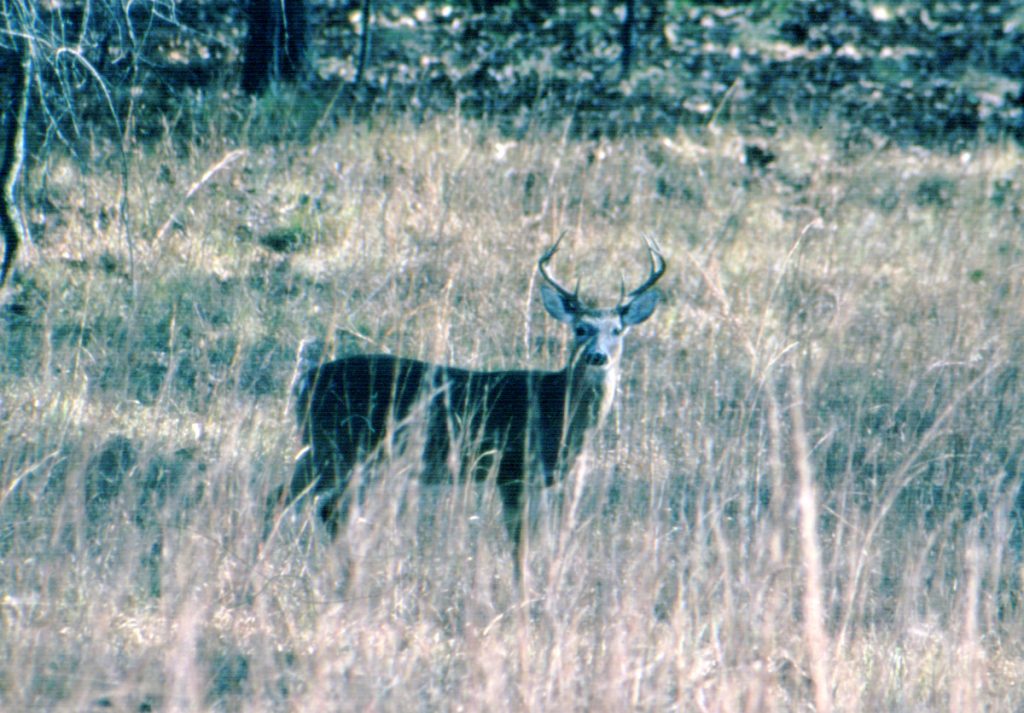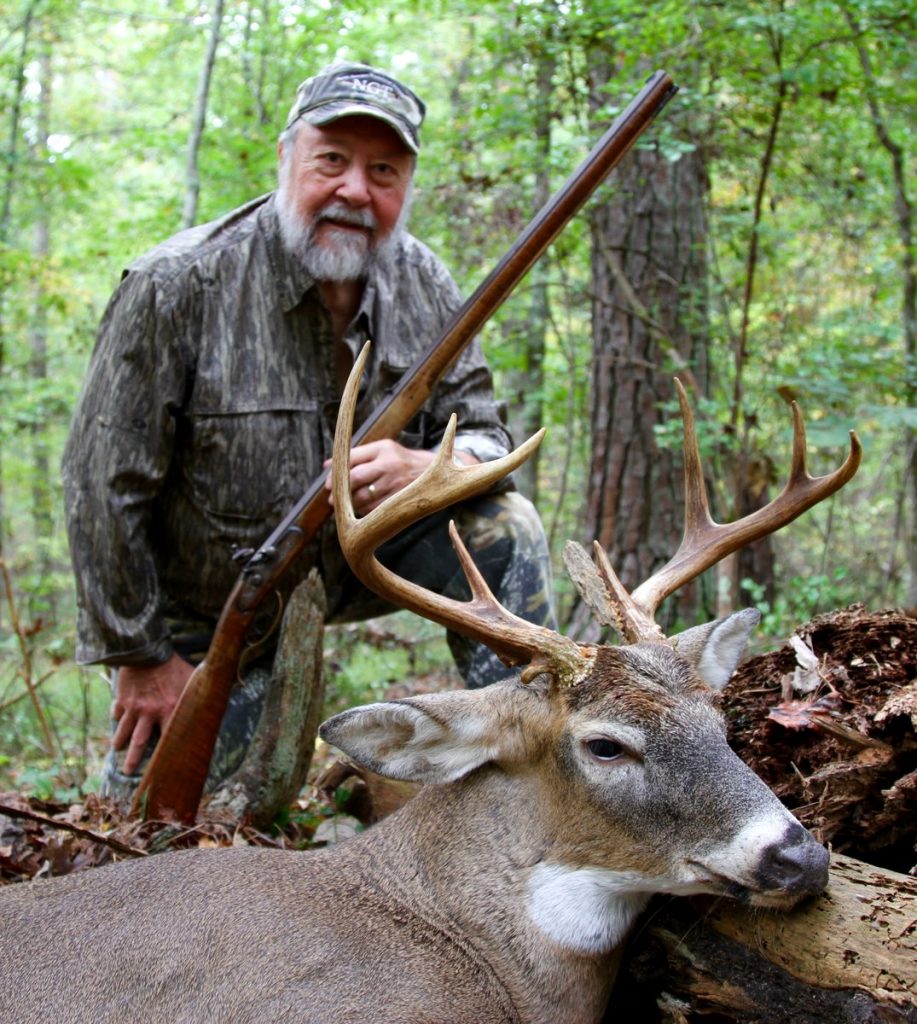Whitetails from half a century apart!
Fall 2025
By Leon Scott
I have been a competitive target shooter since my high school days in the R.O.T.C., but hunting deer became my passion, thankfully tolerated by my lovely and understanding wife – a pretty good shot herself. I taught high school English and coached wrestling, but my spare time from the early 1960s has been spent between the swamps and the mountains with a rifle in my hands.
I’ve been extremely fortunate in my hunting life, and our freezer has generally held a good supply of venison. As a teacher, I’ve always tried to take students hunting with me, and I’ve been a National Rifle Association certified instructor since 1964.
My first published article was about getting started in muzzleloading, when Georgia was contemplating a muzzleloading season. Over the years, I’ve had a good time writing about hunting and fishing in Georgia, and met a lot of good people that are now friends and companions. I joined the Georgia Outdoor Writers Association and expanded my knowledge of writing and the many things our state has to offer an outdoorsman.
Now, I have been honored by being granted one of only three current lifetime memberships in the Georgia Outdoor Writers Association. Their directorship has asked me to tell the story of “My Best Ever Deer Hunt.” When that covers 65 years and over 500 hunts, selection is a challenge. But, here goes.
My best hunt, I felt, was not a single hunt, but two held over 50 years apart. That connection between two such widely spaced hunts is the fact that in both cases, while hunting through woods I hadn’t walked before, I found the sign of what I felt to be a big, likely mature buck. I made the decision to try for those particular deer, not the kind of hunt I usually embarked on. Normally I try to pick a heavily traveled area, at or near a food source, and sit down to wait to see what may come by my way. This time I was going to actively pursue a specific buck.
I was in Worth County, one of the several southwest Georgia counties where big deer from up North had been stocked and protected for five years before any hunting was allowed. This was possible through the cooperation of local landowners who owned large tracts of agricultural land.
The time was early November around 1970. I was still-hunting through an extensive swamp below cornfields in late morning, when I came to a point where the field above me cornered with bottom land and an impenetrable river swamp of briars and brambles.
Along and below the field, my fairly open area was virtually covered with deer tracks in the soft, dark soil. The tracks were milling around the edge of the brush as the deer fed on water oak acorns.
What was most distinctive was one set of huge, deeply imbedded tracks coming in a straight line out of the thickest stuff and apparently moving quickly along and shielded by the elevated field toward where I knew there was a peanut field about a half mile away. My thought was that the big boy left the security of his heavy cover timed to arrive at the peanut field to feed in the safety of the dark.
With the distance he had to travel, I hoped he would leave his sanctuary while some shooting light remained.
I quietly left the area, and returned about 4 p.m. I spread some Parker’s Perfect Deer Lure, an old brand I had enjoyed some success with, across the path of the big tracks. Then I backed off about 50 yards and sat down against a big basswood tree to wait. Thankfully, the wind was in my favor. I was carrying my Browning lever-action rifle chambered in 7mm-08 Remington with a good scope.
As the light started fading, so did my hope. In the very last shooting light, he came loping from the cover right along the same trail as before, no doubt headed towards the peanuts. His rack was wide and tall. He was huge! He hit the scent line I had laid across the trail and locked down. I came up with the my rifle, looked through the scope, and the trees totally blocked his chest area, leaving only his head, neck and butt exposed. His tail stuck straight out, as did his head. For that moment, he was frozen.

The only clear target in the dim light, brown dear against brown leaves, was the white throat patch under his chin on his neck. That’s where my 140-grain bullet went, and he went straight down, thrashing on the leaves. Afraid he would get up and run, I again shot for the white throat patch. That bullet exited through the top of his head and separated his antlers. Thankfully, my taxidermist repaired that problem.
Two lucky shots had given me the biggest buck of my life to that point. We had no way to weigh him, and it was 2 a.m. by the time we got him out of the swamp and up to the field and our truck. I’d swear he was well over 250 pounds. I’ve never been much on scoring my deer, but he was a high, wide 8-pointer with a 16-inch inside spread and a longest tine of 11 inches. I was then, and still am, proud of that calculated hunt where my idea actually worked.
The other half of my best hunt story took place almost a half century later in Meriwether County on October 15, 2017, during muzzleloading season.
I was again still-hunting on a large tract of hardwoods, pines and swamp bottoms late in the afternoon, when I found a large, fresh scrap, with a big hoof print in it. Rather than disturb the scene, I went back to the cabin and spent the night in restless sleep, thinking and dreaming of the deer that left his calling card for me.
In the early morning light I returned to the scrape and slowly and quietly tried to back track the buck along his scrape line as it headed along a ridge through an oak grove toward a bottomland swamp. Just before the oak ridge dropped abruptly into the swamp below, I found what must have been his daylight bedroom. There was a 6-inch diameter dogwood rubbed bright and raw almost as high as my waist. There was one of the largest, fresh scrapes I had ever seen. There was a big red oak dropping acorns like rain. There was ground cover, but still a good view through the oaks and out over the swamp. Best of all, as I sat on the ground against the big red oak, the slight breeze hit me just right.
By now it was 8:30 a.m., and I settled in to wait in the most promising spot I’d seen in years.
I was carrying my favorite woods-walking rifle, a .45 caliber flintlock roundball gun my mentor Schley Howard and I had built in 1962, shaping the stock to fit so I shot where I looked. This was my 55th season hunting with this rifle, and it had taken a good many deer, but never a really big buck. It lay across my lap, pointed toward the trail from the swamp, primed and ready.
At 9 a.m. a nice doe came up from the swamp and passed me at 10 yards, never seeing or smelling me. My heart settled back down, and I stayed motionless, trying to breath softly.
At about 9:15 a beautiful set of antlers appeared, coming up over the hill on the trail the doe had followed. I raised my rifle and, when the buck’s chest appeared 10 yards away, the flintlock went off, and the buck disappeared in a cloud of white smoke. I heard him crashing down through the swamp, and I just sat transfixed. Then my shaking started!
My host had heard my shot, and I heard him coming. I still hadn’t moved. We began the search and didn’t find any blood right away. I was still confident in the shot, and we found the buck after a few minutes, about 60 yards into the swamp. It was a clean heart shot, the ball stopping near the hide on the far side.

The second swamp buck.
His mount hangs beside that buck from 50 years ago. He had eight lovely points and a 17 1/2-inch inside spread. Time separates these two hunts, but the way they played out put them together always in my mind.
As Hannibal Smith of television’s old A-Team show used to say, “I love it when a plan comes together!”
Leon Scott is a retired educator, life member of the Georgia Outdoor Writers Association, a 2010 inductee into the Georgia Hunting and Fishing Hall of Fame and veteran primitive weapons hunter. He now lives in Blue Ridge. Leon can be contacted at 612scott@bellsouth.net.